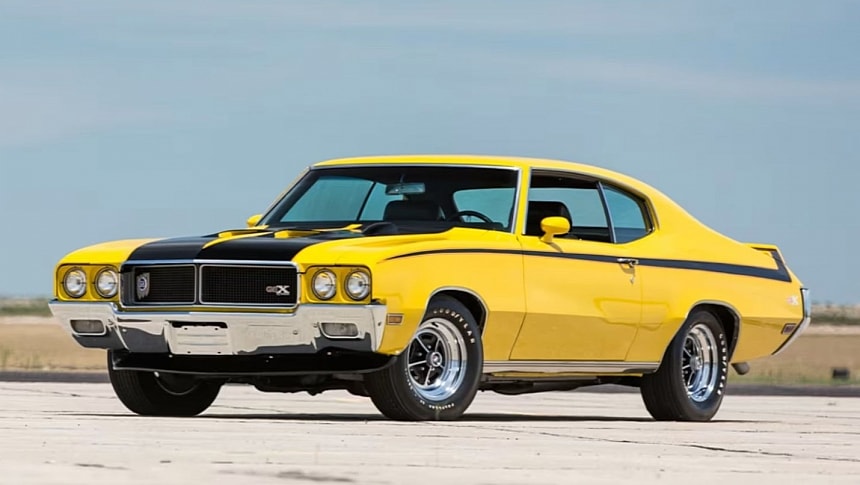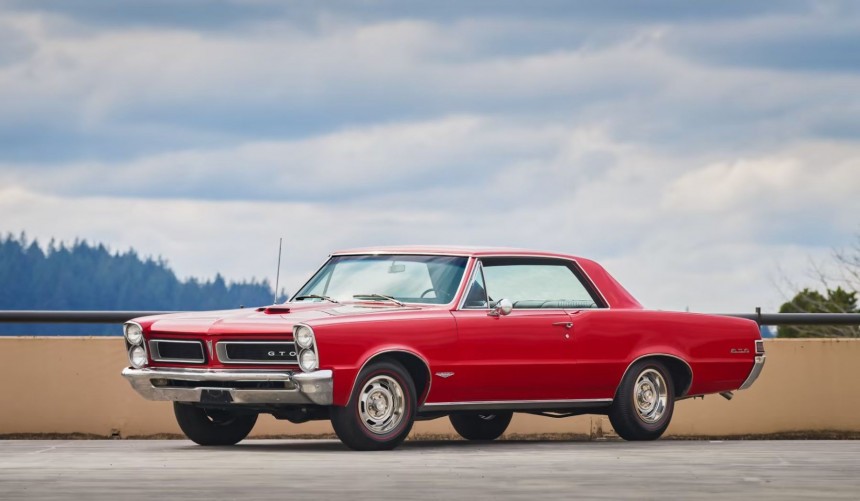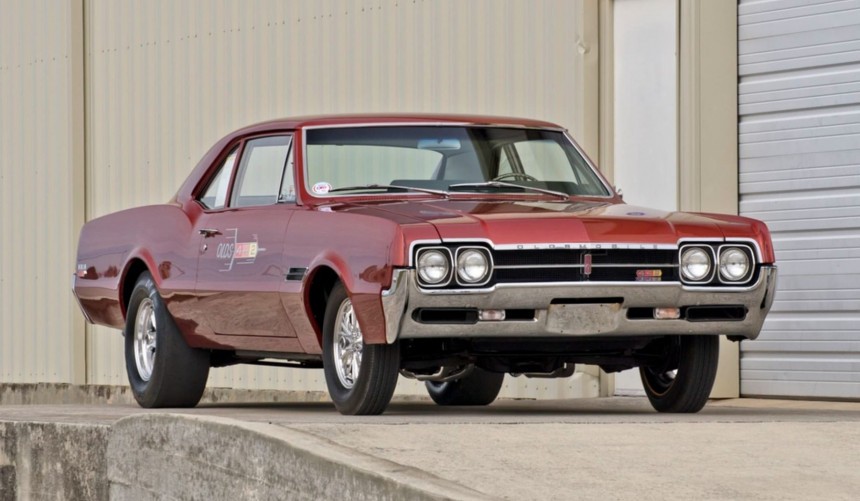During the golden age of muscle, General Motors' A-body platform underpinned some of the most iconic tire shredders in American automotive history.
General Motors was one of the first automotive companies to implement platform sharing to increase production efficiency.
The A platform (later called the A-body) was GM's earliest standardized platform. It underpinned the corporation's early production models (starting with the Chevrolet Superior) and spawned smaller-wheelbase derivatives.
After 1958, the designation was discontinued, but six years later, it returned as GM's new intermediate platform.
In the world of muscle cars, the A-body is synonymous with some of the greatest models ever created, like these five icons that still captivate the hearts and minds of enthusiasts more than half a century after they were produced.
Pontiac kicked off the muscle car wars in 1964 when it added the GTO performance package to the A-body Tempest/LeMans lineup.
The GTO was a success, so naturally, it returned for the 1965 model year with a few noteworthy improvements.
Aesthetically, the muscle car king was now 3.1 inches (79 mm) longer and received a facelift.
However, since it also became 100 pounds (45 kg) heavier, its 389-ci (6.5-liter) V8 was mildly upgraded. In the standard single four-barrel-carb setup, the motor was boosted from 328 to 335 hp, while the optional Tri-Power version went up from 348 to 360 hp.
Though it now had better competition, the GTO remained the quickest, most potent factory-built muscle car in 1965.
According to a test conducted by Car and Life magazine, a Tri-Power-equipped GTO could do 0 to 60 mph (97 kph) in 5.8 seconds, reach a top speed of 114 mph (182.4 kph), and run the quarter mile in 14.5 seconds at 100 mph (160 kph), all with a driver, a passager, and heavy measuring equipment inside.
Halfway through the 1964 model year, Oldsmobile developed its own GTO-rivaling performance package for the Tempest/LeMans' A-body cousins, the Cutlass/F-85.
However, the package dubbed 4-4-2 was no match for the GTO in its initial form or the improved 1965 version.
For the 1966 4-4-2, Olds engineers led by the legendary John Beltz improved the L78 400-ci (6.5-liter) big-block V8, taking it to 350 hp, but they didn't stop there.
By the midway point of the model year, they launched an optional 400, codenamed L69, equipped with revised cylinder heads and a trio of two-barrel carbs atop a new intake manifold.
Furthermore, a few months later, the W30 Fresh Air Option package was added for the L69, bringing factory blueprinting, a hotter cam, and a two-piece dual-snorkel air intake.
Whether it was equipped with the W30 option or not, the Tri-Power Olds engine was conservatively rated at 360 hp, just like the Pontiac 389.
However, independent tests conducted by top magazines concluded that the 4-4-2 was faster than the GTO or any other factory-built muscle car available in 1966.
In 1968, GM's entire A-body lineup was redesigned, and apart from the now-established 4-4-2, Olds added a second high-performance model to its lineup.
For several years, Oldsmobile's enthusiastic engineers involved in the 4-4-2 project wanted to equip the muscle car with the division's 455-ci (7.5-liter) V8, but GM's internal 400-ci (6.6-liter) ban on intermediate-bound V8s prevented that from happening.
Nevertheless, they didn't give up on the idea and eventually figured out that getting Hurst Performance to assemble the engine inside a 4-4-2 would bypass the internal ban.
Hurst was more than happy to help, and the only pre-1970 GM intermediate powered by a 455 V8 was born.
Called Hurst/Olds, the new model was only available in a bespoke silver and black finish that differentiated it from the standard 4-4-2.
Its gargantuan Rocket V8 was factory-rated at 390 hp and 500 lb-ft (678 Nm) of torque, which allowed the Hurst/Olds to run the quarter mile in 13.71 seconds at 102.2 mph (164.4 kph).
In 1965, Buick also stepped into the muscle car arena with the A-body Skylark-bound Gran Sport package. However, like Oldsmobile's 4-4-2, it was no match for the GTO in terms of sales.
Despite that, Buick continued to offer the Gran Sport in the years that followed, and the gentleman's muscle car became better with each new iteration.
In 1970, GM finally lifted its 400-ci ban, so its divisions launched a large-displacement onslaught on its rivals.
The Gran Sport received a 455-ci (7.5-liter), which, despite having the same displacement as the Olds Rocket V8, was completely developed by Buick's engineers.
Conservatively rated at 350 hp and , the new large-displacement engine was available with an optional performance package called Stage 1 that brought several upgrades, such as larger valves, a more aggresive cam, and a larger four-barrel carb.
According to Buick, the Stage 1 package only added ten extra horses, but in reality, it pushed the 455 much closer to the 400-hp mark.
Whether equipped with the Stage 1 package or not, the Buick V8 was rated at 510 lb-ft (691 Nm) of twist, which was the highest factory torque figure of any golden-age muscle car.
Apart from the standard Gran Sport, Buick also introduced the flashier GSX in 1970. While it came with a different yellow and black finish, the GSX was mechanically identical.
For the 1970 model year, the Chevelle, as well as all other GM A-body intermediates didn't receive many aestetic upgrades, since the platform received a major redesign just two years earlier.
However, with the 400-ci ban lifted, the high-performance Chevelle SS became a different monster.
While the 402 (marketed with 396 badges) continued to be the standard engine for Chevy's Chevelle SS A-body muscle car, like its GM siblings, the division launched a new large-displacement big-block V8.
The new optional Turbo-Jet displaced 454 ci (7.4 liters) and was available in two distinct configurations.
The first was the LS5, which produced a cool 360 hp, while the second, codenamed LS6, ramped up power to an unprecedented 450 hp thanks to upgrades like four-bolt mains, a forged steel crank, forged steel conrods, forged aluminum pistons, solid lifters, and a larger 800-cfm Holley four-barrel carb mounted on top of a low-rise aluminum manifold.
Equipped with the latter, the Chevelle SS was not just the quarter-mile king of 1970 (13.12s at 107 mph/172.2 kph) but was the most powerful factory-built muscle car of the era.
The A platform (later called the A-body) was GM's earliest standardized platform. It underpinned the corporation's early production models (starting with the Chevrolet Superior) and spawned smaller-wheelbase derivatives.
After 1958, the designation was discontinued, but six years later, it returned as GM's new intermediate platform.
In the world of muscle cars, the A-body is synonymous with some of the greatest models ever created, like these five icons that still captivate the hearts and minds of enthusiasts more than half a century after they were produced.
1965 Pontiac GTO 389 Tri-Power
The GTO was a success, so naturally, it returned for the 1965 model year with a few noteworthy improvements.
Aesthetically, the muscle car king was now 3.1 inches (79 mm) longer and received a facelift.
However, since it also became 100 pounds (45 kg) heavier, its 389-ci (6.5-liter) V8 was mildly upgraded. In the standard single four-barrel-carb setup, the motor was boosted from 328 to 335 hp, while the optional Tri-Power version went up from 348 to 360 hp.
Though it now had better competition, the GTO remained the quickest, most potent factory-built muscle car in 1965.
According to a test conducted by Car and Life magazine, a Tri-Power-equipped GTO could do 0 to 60 mph (97 kph) in 5.8 seconds, reach a top speed of 114 mph (182.4 kph), and run the quarter mile in 14.5 seconds at 100 mph (160 kph), all with a driver, a passager, and heavy measuring equipment inside.
1966 Oldsmobile 4-4-2 W30
However, the package dubbed 4-4-2 was no match for the GTO in its initial form or the improved 1965 version.
For the 1966 4-4-2, Olds engineers led by the legendary John Beltz improved the L78 400-ci (6.5-liter) big-block V8, taking it to 350 hp, but they didn't stop there.
By the midway point of the model year, they launched an optional 400, codenamed L69, equipped with revised cylinder heads and a trio of two-barrel carbs atop a new intake manifold.
Furthermore, a few months later, the W30 Fresh Air Option package was added for the L69, bringing factory blueprinting, a hotter cam, and a two-piece dual-snorkel air intake.
Whether it was equipped with the W30 option or not, the Tri-Power Olds engine was conservatively rated at 360 hp, just like the Pontiac 389.
However, independent tests conducted by top magazines concluded that the 4-4-2 was faster than the GTO or any other factory-built muscle car available in 1966.
1968 Hurst/Olds
For several years, Oldsmobile's enthusiastic engineers involved in the 4-4-2 project wanted to equip the muscle car with the division's 455-ci (7.5-liter) V8, but GM's internal 400-ci (6.6-liter) ban on intermediate-bound V8s prevented that from happening.
Nevertheless, they didn't give up on the idea and eventually figured out that getting Hurst Performance to assemble the engine inside a 4-4-2 would bypass the internal ban.
Hurst was more than happy to help, and the only pre-1970 GM intermediate powered by a 455 V8 was born.
Called Hurst/Olds, the new model was only available in a bespoke silver and black finish that differentiated it from the standard 4-4-2.
Its gargantuan Rocket V8 was factory-rated at 390 hp and 500 lb-ft (678 Nm) of torque, which allowed the Hurst/Olds to run the quarter mile in 13.71 seconds at 102.2 mph (164.4 kph).
1970 Buick Gran Sport/ GSX Stage 1
Despite that, Buick continued to offer the Gran Sport in the years that followed, and the gentleman's muscle car became better with each new iteration.
In 1970, GM finally lifted its 400-ci ban, so its divisions launched a large-displacement onslaught on its rivals.
The Gran Sport received a 455-ci (7.5-liter), which, despite having the same displacement as the Olds Rocket V8, was completely developed by Buick's engineers.
Conservatively rated at 350 hp and , the new large-displacement engine was available with an optional performance package called Stage 1 that brought several upgrades, such as larger valves, a more aggresive cam, and a larger four-barrel carb.
According to Buick, the Stage 1 package only added ten extra horses, but in reality, it pushed the 455 much closer to the 400-hp mark.
Whether equipped with the Stage 1 package or not, the Buick V8 was rated at 510 lb-ft (691 Nm) of twist, which was the highest factory torque figure of any golden-age muscle car.
Apart from the standard Gran Sport, Buick also introduced the flashier GSX in 1970. While it came with a different yellow and black finish, the GSX was mechanically identical.
1970 Chevrolet Chevelle SS 454 LS6
However, with the 400-ci ban lifted, the high-performance Chevelle SS became a different monster.
While the 402 (marketed with 396 badges) continued to be the standard engine for Chevy's Chevelle SS A-body muscle car, like its GM siblings, the division launched a new large-displacement big-block V8.
The new optional Turbo-Jet displaced 454 ci (7.4 liters) and was available in two distinct configurations.
The first was the LS5, which produced a cool 360 hp, while the second, codenamed LS6, ramped up power to an unprecedented 450 hp thanks to upgrades like four-bolt mains, a forged steel crank, forged steel conrods, forged aluminum pistons, solid lifters, and a larger 800-cfm Holley four-barrel carb mounted on top of a low-rise aluminum manifold.
Equipped with the latter, the Chevelle SS was not just the quarter-mile king of 1970 (13.12s at 107 mph/172.2 kph) but was the most powerful factory-built muscle car of the era.






